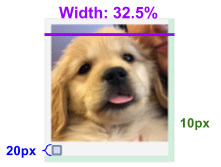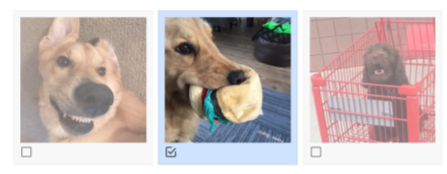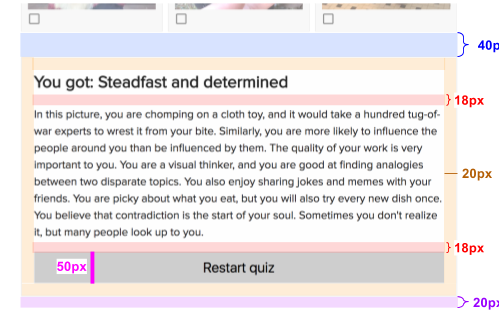In this project, you will be practicing the HTML, CSS, and JavaScript.
You will exercise what you've learned about the DOM, DOM events, object-oriented programming, ES6+ coding, and more.
Specifically you will create a personality quiz. Much of the HTML and CSS is already implemented for you, but you will still need to make some HTML and CSS modifications to complete the assignment. None of the JavaScript has been implemented for you, other than constants.js that constants the quiz result information.
Getting started
Download workspace starter (zip) here
Personality Quiz
index.html
For Part 1, you will create a personality quiz called “Adopt A Dog And We’ll Reveal A Deep Truth About You.”
We have completed a lot of the HTML and CSS for you already. We expect you will have to make modifications to the following files to complete the assignment:
-
index.html: Most of the HTML is written for you, but you will likely need to make some modifications for the mobile layout and the JavaScript. -
style.css: A lot of the CSS is already written for you inprovided-style.css, but you will need to make some modifications for all parts of the assignment. Please make your CSS changes instyle.cssand notprovided-style.css, so that the TAs have an easier time grading. -
script.js: Write your JavaScript here.
Overall appearance and behavior
The following video shows the look and behavior of the quiz we are asking you to implement.
One detail that is hard to see in the video:
- After the quiz is completed (i.e. after all three questions have been answered), it should not be possible to change your answer anymore.
1. Choice grid
Much of the CSS has already been completed for you, but you need to finish styling the answer choice grids.
Choice grid

-
You should use a multi-row flexbox to achieve
this layout.
-
We didn’t talk about multi-row flexbox layout in class,
but you can allow flex items to wrap onto the next line
(i.e. the second row) by setting
flex-wrap: wrap;onto the flex container.
-
We didn’t talk about multi-row flexbox layout in class,
but you can allow flex items to wrap onto the next line
(i.e. the second row) by setting
-
There is
20pxof space between each row -
Each flex item has a width of
32.5%, and each item is spread out with as much space between the other as there can be in the flex container.
Choice: unanswered

-
Container
-
Background color is
#f4f4f4 -
Border is
1pxthick and color is#dcdcdc -
Width of the element including the border
is
32.5%-
Hint: The
box-sizingCSS property might be helpful. See April 12 slides.
-
Hint: The
-
Space between the border and the content of the element is
10px.
-
Background color is
-
Choice image (i.e. dog, house, or toy image)
-
Hints: We did not tell you the width or
height of the image intentionally, as we want you figure
out how to get it to behave like this. There are many ways
to get the images to “shrink” inside its container
-
The
tic-tac-toe example
has almost the same layout, and fits the X and O
images into the invisible
<div>containers. Take a look at the CSS for this example. - The beverage image of HW1 also had similar behavior. Recall what dimensions we gave you for the beverage image.
- You are allowed to modify the HTML if you’d like (but you don’t necessarily have to if you choose a different approach)
-
You might also find
:first-childpseudo-selector helpful (but you don’t necessarily have to if you choose a different approach)
-
The
tic-tac-toe example
has almost the same layout, and fits the X and O
images into the invisible
-
Hints: We did not tell you the width or
height of the image intentionally, as we want you figure
out how to get it to behave like this. There are many ways
to get the images to “shrink” inside its container
-
Checkbox
-
The unchecked image is
images/unchecked.png -
The height and width is of the image is
20px -
Note: Do not use an
<input type="checkbox" />for this. Just display the image.
-
The unchecked image is
2. Mobile layout
You need to also modify the CSS and HTML if necessary to implement support a mobile view. The video below shows an example of how it should look and behave:
Please see April 14 Slides for details on how to implement and test your homework layout in mobile view on your desktop Chrome.
Note: You should not have to load your web page on your phone in order to test this layout. Emulate mobile in Chrome.
-
If the page is viewed on mobile:
- The viewport should be set to zoom-level 100%, and the width should be the device width
-
If the device screen size is less than
700pxwide:-
The width of the page content should be
95%instead of700px - The yellow circles in the page header should not appear
-
The width of the page content should be
-
If the device screen size is less than
500pxwide:-
Each answer choice should be
49%in width instead of32.5%
-
Each answer choice should be
3. Quiz behavior
This web page is a 3-question personality quiz. Write the code necessary to implement the quiz behavior as detailed below.
Even though you will mostly be writing JavaScript for this part, you may need to also update the HTML or CSS in order to implement the behavior as described.
Hint: Aspects of the quiz are quite similar in behavior to the tic-tac-toe.html example discussed in lecture.
Dataset Attributes
Note that you should take advantage of the
dataset attributes
added to the HTML elements in
index.html:
-
data-choice-id: Maps to which quiz result the choice should “count” for, as defined inconstants.js. See details below for scoring and what to do if there are ties. -
data-question-id: Maps to the question number: one, two, and three.
You can access these attributes in JavaScript by using:
-
element
.dataset.choiceId -
element
.dataset.questionId
And you can select these attributes via CSS selectors like the following:
-
[data-choice-id='blep'] -
[data-question-id='two']
Clicking an answer
When the user clicks an answer choice, the answer choices should update in the following way:

-
For the selected item:
- The checkbox image should change from unchecked to checked
-
Background color is
#cfe3ff -
The checked image is
images/checked.png
-
For the unchosen items:
-
They should be made semi-transparent by setting their
opacity: 0.6; - Note that only the unchosen items for this question should change style.
-
They should be made semi-transparent by setting their
Changing an answer
If the user has not completed the quiz (i.e. there is at least one unanswered question), they should be able to change their answer to a question by clicking a different answer.
After the user has answered every question, the answer choices should lock and it should no longer be possible to change an answer, until the user clicks “Restart quiz” or refreshes the page.
Completing the quiz
After the user has answered all three questions, the quiz is complete.
-
It should not be possible to select another answer after
you’ve completed the quiz.
- i.e. you click another dog after the quiz is complete, nothing on the page should change.
- The page should remain in this “completed” state until the user refreshes the page or clicks “Restart quiz”.
The personality results should appear at the bottom of the page,
with the personality data that corresponds to the dog, as
defined by constants.js.
Here is the description of how the personality results should look:

-
Result button
-
Background color is
#cecece -
On hover, the color should change to
#e0e0e0
-
Background color is
Scoring the quiz
The data-choice-id for
each answer choice maps to the key name for each possible result
in RESULTS_MAP, stored in
constants.js. You can
access RESULTS_MAP in
script.js because
constants.js is included
before script.js in
index.html.
When the quiz is complete, you can score the quiz by tallying
the data-choice-ids from
each answer. For example, if a user chooses
blepdog.jpg,
sleepybed.jpg, and
bleptoy.jpg, you should
show the title and contents from
RESULTS_MAP['blep'].
If there is a tie, i.e. if someone chooses all unique
data-choice-ids, the
answer to the first question should win. For example, if a user
chooses burgerdog.jpg,
nerdbed.jpg, and
shydog.jpg, you should
show the title and contents from
RESULTS_MAP['burger'].
Resetting the quiz
If the user clicks the “Restart quiz” button, the page should reset to its original state.
- The answer choices should return to their original appearance before the quiz was complete
- The personality results should disappear
- The answer choices should be selectable again, and clicking on a different set of answers should result in showing an updated personality type.
- The page should look and behave the same as if you had refreshed the page (but you should not actually refresh the page)
-
You should also make the page scroll to the top of the “Pick a
pup” element.
-
You can call
element.scrollIntoView();to do this. See mdn for more details.
-
You can call
constants.js
-
This file contains the definition of the object
RESULTS_MAP, which maps the dog type to its result title and description. -
Because this variable is declared in the global scope, you can
access this variable in
script.js. - You should not have to modify this file to solve the homework.
script.js
- This is the file in which we expect you to implement the quiz behavior.
- You should define and attach event listeners in this file.
Image to personality mapping
The RESULTS_MAP is
defined in
constants.js and the
images are saved in the
images/ directory.
-
blep{dog,bed,toy}.jpgcorresponds toblepinRESULTS_MAP -
happy{dog,bed,toy}.jpgcorresponds tohappyinRESULTS_MAP -
sleeping{dog,bed,toy}.jpgcorresponds tosleepinginRESULTS_MAP -
dopey{dog,bed,toy}.jpgcorresponds todopeyinRESULTS_MAP -
burger{dog,bed,toy}.jpgcorresponds toburgerinRESULTS_MAP -
cart{dog,bed,toy}.jpgcorresponds tocartinRESULTS_MAP -
nerd{dog,bed,toy}.jpgcorresponds tonerdinRESULTS_MAP -
shy{dog,bed,toy}.jpgcorresponds toshyinRESULTS_MAP -
sleepy{dog,bed,toy}.jpgcorresponds tosleepyinRESULTS_MAP
NOTE: To make this easier to test, the items
for each question are in the order displayed above, i.e. the
first answer of every question maps to
blep, the second answer
of every question maps to
happy, etc.
You should not rely on this ordering for your homework
solution.
Instead, use the dataset attributes as described at the top of
this section.